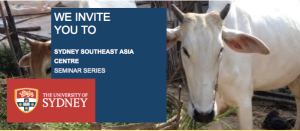Home » Posts tagged 'Livestock'
Tag Archives: Livestock
Working with smallholder farming families, their livestock and FMD viruses in the Mekong & beyond
Peter Windsor, Isabel MacPhillamy, Francesca Earp
In our efforts to understanding how to improve livelihoods in rural SE Asia & regional food security, we are assisting the transition of some subsistence smallholder farmers from poverty to a more viable and sustainable livelihood through investing in improved livestock productivity. This work is focused on what motivates farmers to change their husbandry practices, including better feeding, preventative health & welfare, and improved household financial resilience. The collaborative work has been almost continuous since 2007 in the Mekong, supported by ACIAR-funded projects now completed in Cambodia & nearing completion in Laos, plus a DFAT Business Partnership Platform project that is current in Laos under a recently revised MOU between the partners (Figure 1). Fortunately we have been able to value-add these funding sources by successfully seeking numerous additional sources of support, including the Crawford Fund for field officer extension training, the New Colombo Plan for student participation, John Alwright, John Dillon and Australian Government Fellowship Awards for assisting Mekong scholars, plus collaborations with international agencies (eg OIE, ADB) and universities.

Our work has been examining, through various socioeconomic survey techniques and measures of cattle and buffalo husbandry, health and production, the best interventions for collaborating smallholder farmers to adopt, whilst assisting us to address gender issues on smallholder farms.
The introduction of forage systems and more recently, molasses feed blocks, decreases the work load of ‘cut & carry’ feeding due to ease of supplying readily available nutrition of improved quantity & quality, creating more time for other work/activities and more easily managed livestock. Lao farmers are impressed by the ease of mustering cattle back to villages for overnight housing as the animals seek access to nutrient supplementation blocks containing molasses (Figure 2). As of mid-November the BPP has moved into a commercial pilot stage that is testing the marketability of blocks to farmers, particularly those that participated in previous efficacy trials and appreciate the production benefits achieved by enhanced nutrition. These blocks are now readily available from the SK Vet Clinic in Luang Prabang (Figure 3 & 4), along with project handbooks on livestock husbandry, reproduction and biosecurity.

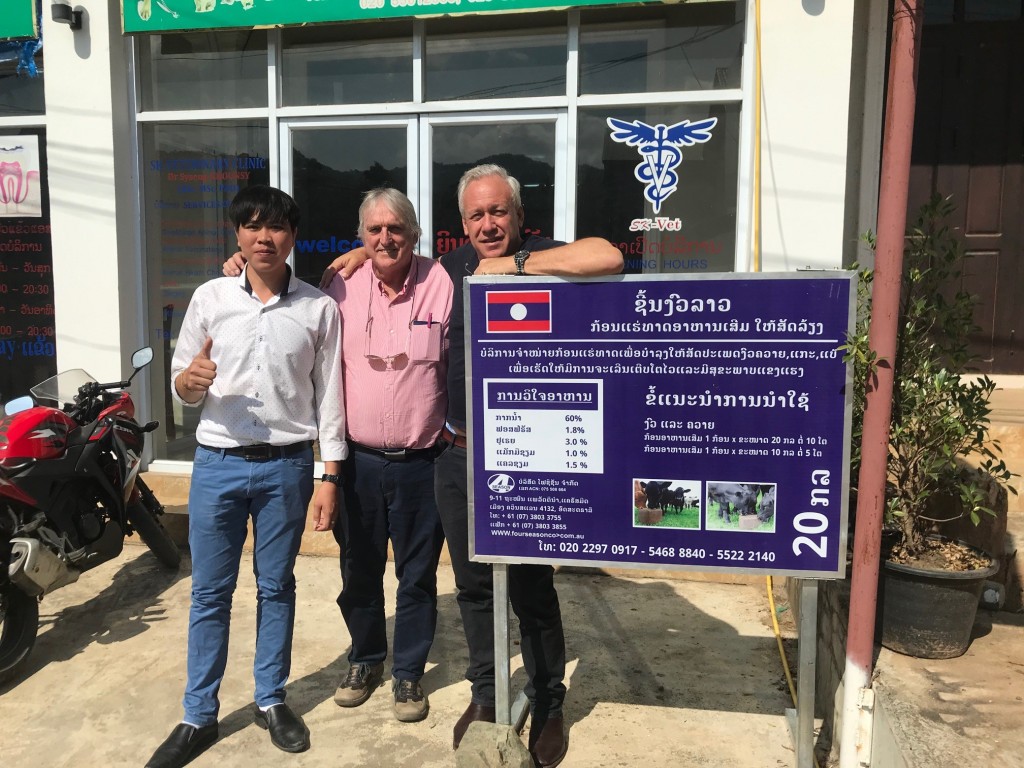
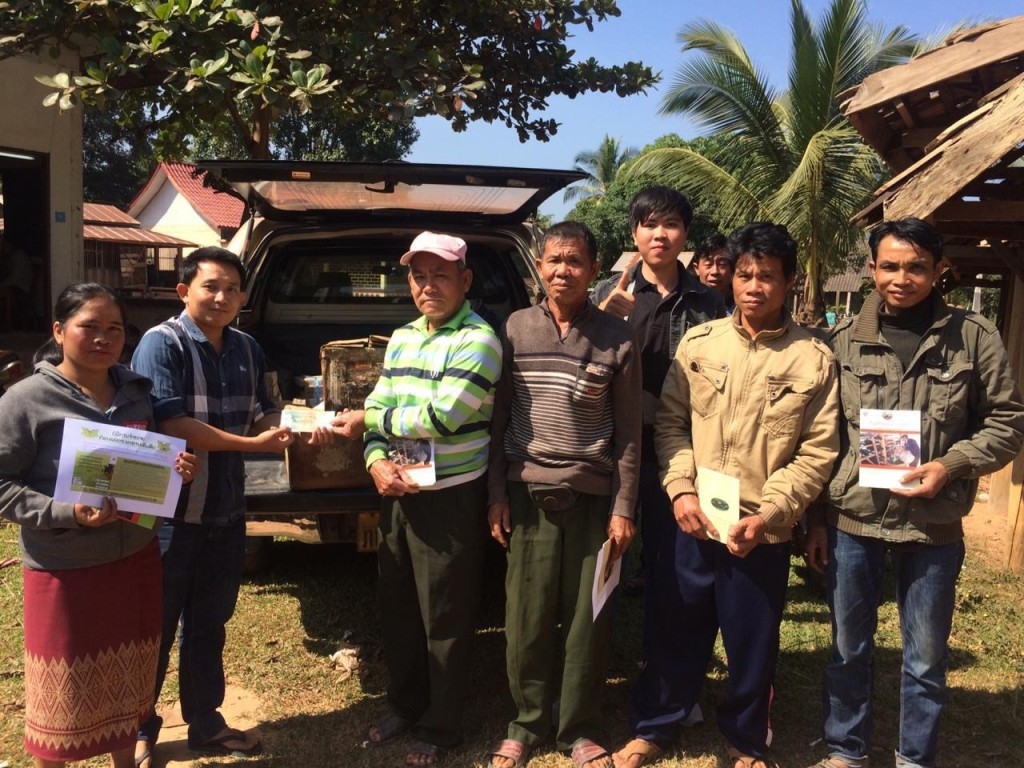
Farmers have also been impressed with how calf mortality is controlled by simply deworming neonates for the roundworm Toxocara vitulorm and that regular vaccination protects against mortality and morbidity from Haemorrhagic septicaemia and Foot-and-Mouth Disease (FMD). More recently, they have been impressed that treatment of FMD lesions with a simple spray of the wound therapy Tri-Solfen provides relief from suffering, hastening healing and saving on the costs of not treating animals with expensive and unnecessary antibiotics (Figure 5).

A very important component of our work is to let the scientific community know of the impact of the research and sharing the findings as they may be of benefit to other development programs throughout the world. Our MLR team member and PhD candidate Franny Earp, who has been living in Laos much of this year, recently won a presenters award at the ISESSAH (International Society of the Economics and Social Sciences of Animal Health) South East Asia Conference, in Bogor, Indonesia, October 17-18 (Figure 6). This followed her presentation on aspects of socioeconomic modelling of preventative health options data from our projects in Laos, as part of her PhD.
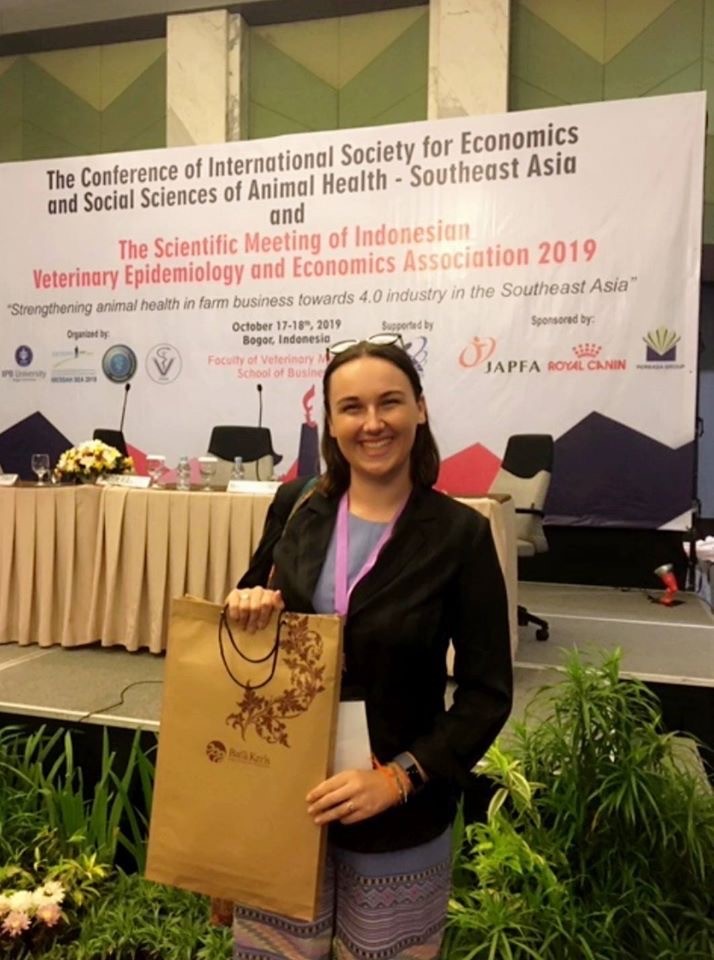
Even more recently, MLR team members Isabel MacPhillamy (Figure 7) and Peter Windsor presented papers at the GFRA (Global FMD Research Alliance) 2019 scientific meeting, in Bangkok, Thailand, October 29-31, discussing all things FMD. Isabel addressed the current challenges in implementing effective biosecurity on smallholder farms in the Mekong. Peter introduced the recent findings from Laos on the use of Tri-Solfen as a novel treatment for FMD, suggesting the likelihood that this approach should be part of more effective strategies to reduce antimicrobial use in livestock and limit the serious risk to the human population from AMR (antimicrobial resistance). The Australian company that produces this product (Medical Ethics; ME) agreed to be sponsors of the conference and the ME desk was very well attended. During the meeting, images were received of cattle with FMD in Nigeria also having been treated (Figure 8). A number of conference attendees from other countries took home samples of the product for trials, including scientists from India, Bangladesh, Kenya and Cameroon. Already, cattle and sheep with FMD lesions in Cameroon have now received pain relief treatment for their FMD lesions.
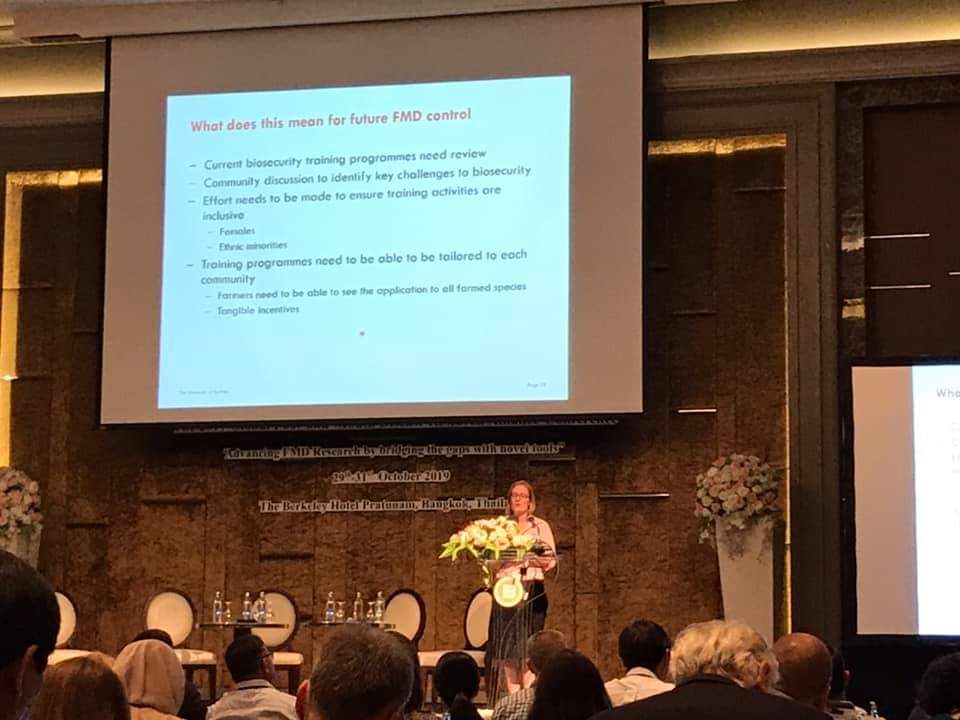
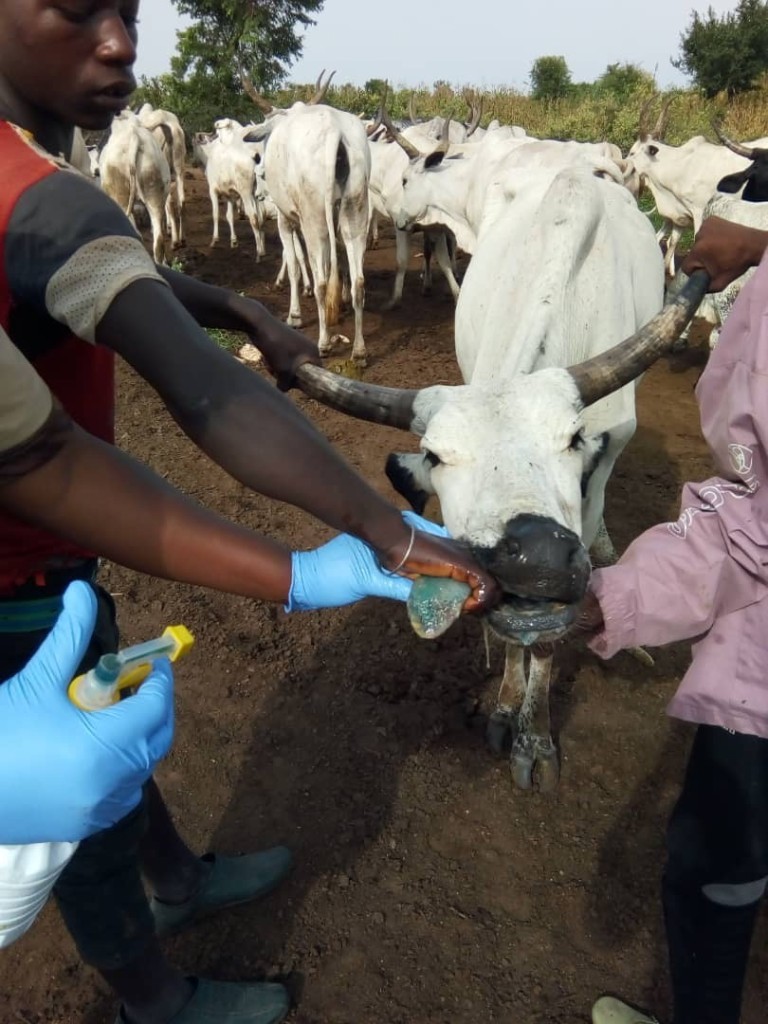
Our extensive work in the Mekong has shown the importance of a systems approach that improves rural livelihoods through increased productivity, focused initially on enhancing nutrition and reducing mortality risk. As learning has continued in our programs, many farmers have continued to improve their livestock husbandry skills and have recognised that healthier more valuable livestock offer pathways for reducing food insecurity and improving rural community resilience. This applied research model from the Mekong, as is well documented on the MLR website under the Resources then Publications tabs
(https://mekonglivestock.wordpress.com/publications), provides ample evidence that where demand for beef remains strong, enhancing productivity leads to improved animal health and welfare outcomes, with better lives for farmers and their animals through reduced rural poverty. The work of the MLR group is now ready for scale-out!
Enhancing rural livelihoods in Laos by farmer training cross visits
By Francesca Earp, edited by Peter Windsor
Long term research by its nature, often means there is a lack of obvious short-term outcomes, unless extension activities to share research findings with other farmers, are efficiently practiced. The recent Farmer Cross Visit in Laos was a firm reminder of how important these research projects are in improving farmer education and practices. The Farmer Cross Visit provided excellent opportunities for farmers to teach and learn about farm management and new on-farm interventions and activities that improve their livelihoods.
On the 15th of January 2019, the Luang Prabang field team and I travelled to Vientiane and joined over 50 farmers and district staff from our four project provinces, to observe some ‘Champion farms’ in action. The day was hosted by the Lao Quality Beef initiative (LQBI) and consisted of talks by the members of the project team and the farmers, then a question and answer session, followed by tours of farms. The attendees were introduced to the importance of appropriate feeding, cattle housing and new technologies as ways to improve their farms productivity levels.
 The MLR team is very appreciative of the LQBI for collaborating on this excellent farmer activity (Photo: Kivor Phanthavong)
The MLR team is very appreciative of the LQBI for collaborating on this excellent farmer activity (Photo: Kivor Phanthavong)
The LQBI commenced in 2017 and is an in-country project in partnership with the New Zealand Government. The project is aimed at improving beef production in Laos to ensure food security and improved productivity. The morning commenced with introductions of each of the ‘Champion farmers’ and presentations on the project’s success thus far.
The morning workshop focused on cattle feeding, providing instructions on silage production and its uses, making hay out of unused rice straw, and the composition of diets using supplementation. Much of this information was novel to the farmers with most farms in Laos currently allowing cattle to free graze as their main form of feeding. This means that currently, growth performance of Lao cattle is predominantly derived from naturally occurring native grasses of variable and often low quantity and quality. With native grass species having a low nutritive value, the recommendations on appropriate cattle diet provided were particularly important. Over coming weeks, the dry season will continue to reduce the quality of pasture, causing declines in growth rates of beef cattle. The attendees were provided with handbooks outlining the composition of new diets for cattle and were encouraged to use the diet plans on their own smallholder farms.
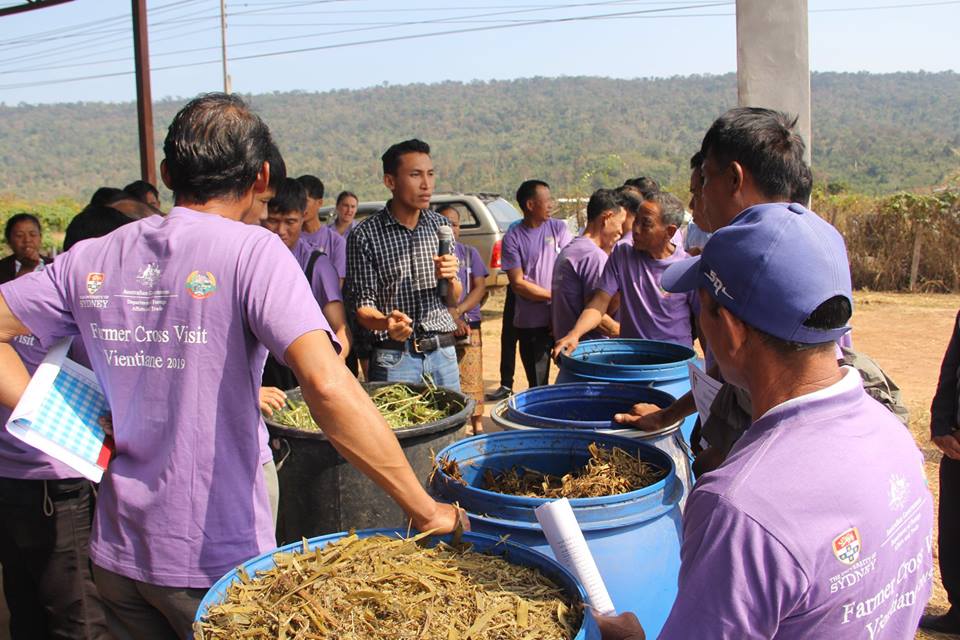 Farmers learning about silage production. In Laos silage is generally made and stored in tubs, rather than the big pits we are familiar with in Australia (Photo: Kivor Phanthavong)
Farmers learning about silage production. In Laos silage is generally made and stored in tubs, rather than the big pits we are familiar with in Australia (Photo: Kivor Phanthavong)
Housing of cattle was another focus of the training, with housing methods and stocking rates within them demonstrated. A common problem within smallholder farms is the overstocking of cattle pens, compromising the growth rate of the animals. It was valuable for the farmers to tour the ‘champion farms’ and see the various housing methods used on the large, medium and small-scale champion farms. Within these housing facilities appropriate feeding and water apparatuses as well as use of cattle crushes were demonstrated and the attending farmers had opportunities to use cattle scales and the cattle crushes.
 Learning about pen stocking density is important to maintain adequate health and hygiene (Photo: Kivor Phanthavong)
Learning about pen stocking density is important to maintain adequate health and hygiene (Photo: Kivor Phanthavong)
The cross visit also aimed to showcase new technologies available within the Laos agricultural scene, including the use of electric fences. These fences were seen on the medium and large-scale farms providing both perimeter and subdivision fencing. This is an important initiative as it provides divisions within the farms to improve pasture management and reduce the occurrence of co-grazing with neighboring farms. Refusing co-grazing with neighboring villages is an important biosecurity measure for disease mitigation as it limits the potential spread of important diseases. Reducing the risk of FMD in Laos has been an important focus of our projects, as was demonstrated by our recently published research: https://mekonglivestock.wordpress.com/wp-content/uploads/2018/09/miller-et-al-2018.pdf.
Research has shown that ‘Farmer Cross Visits’ are a very effective strategy in agricultural extension in Laos. This strategy has been promoted regularly in our ‘Train the Trainer’ workshops funded through our ACIAR plus Crawford Fund and DFAT-BPP (Business Partnership Platform) supported projects on cattle production. In addition to forage production, silage, cattle nutrition and handling, we have been promoting disease control through biosecurity and vaccination, plus nutrient molasses block supplementation and parasite control. Applied participatory research & extension projects that use a combination of these strategies are proving powerful in changing farmers attitudes and practices from a traditional subsistence approach to a productivity focus. These projects allow farmers to ‘Learn by Doing’ as they measure the weight gains and observe the improved incomes from more efficiency livestock raising, resulting in enhanced family livelihoods.
The ‘Farmer Cross Visit’ day concluded with a question and answer session providing the farmers with opportunities to clarify issues and concerns with the practices they had observed and participated in. The farmers were very enthusiastic and appreciative of the learning provided. On days like this, we are reminded of the importance of the work we are doing and the collaborations between Lao, Australian and New Zealand institutions, including funding agencies such as ACIAR and DFAT, that support these contributions. The obvious improvements on the farms visited that are applying these interventions, in addition to the capabilities of the farmers to teach and learn from each other, made for an inspiring educational day. I was very proud to be involved.

Some farm visits aren’t complete without at tree bridge crossing (Photo: Kivor Phanthavong)
City University of Hong Kong helps to progress bovine reproductive disease knowledge in smallholder farms in Laos and Cambodia
Author: Luisa Olmo; Edited by Dr. Susan Pfeiffer, City University

The College of Veterinary Medicine and Life Sciences at City University of Hong Kong (CityU) hosted University of Sydney PhD student Luisa Olmo for two weeks and assisted in serological analysis of over 1000 cattle and buffalo sera samples from Laos and Cambodia at CityU’s Veterinary Diagnostic Laboratory.
Luisa has been working with the University of Sydney’s Mekong Livestock Research team for three years on projects collaborating with the Department of Livestock and Fisheries, Laos, and the General Directorate of Animal Health and Production, Cambodia, and funded by the Australian Centre for International Agricultural Research. Starting as an honours student, she spent one month in Cambodia and assessed interventions to improve the reproductive efficiency of the country’s bovines through knowledge, attitude and practice (KAP) surveys conducted on smallholder farmers. This identified the use of native cattle, bull selection, target feeding, vaccinating for Foot and Mouth Disease (FMD) and forage growing as evidence based interventions to enhance reproductive efficiency. Her current PhD extends the research scope to include neighbouring Laos and their larger populations of buffalo, which are less fertile than cattle in these environments. Luisa lived in Laos for 9 months, learning Lao language, interviewing farmers in southern Laos, working with government staff to deliver knowledge building workshops, and navigating though serum banks.
A large resource of cattle and buffalo serum already exists in Laos and Cambodia from previous Foot and Mouth Disease (FMD) monitoring projects. Locating and organising these samples has led to in-country agreements to allocate a subset of serum to investigate pathogens with the potential to cause reproductive loss that have not been previously screened for in Laos and Cambodia. The investigation of these diseases is important because reproductive efficiency is currently constrained with the native Laotian cattle and water buffalo having average intercalving intervals of 14 to 16 months and 19 to 26 months, respectively, and the Cambodian Haryana native cross of 21 months. With the Lao population and its beef consumption projected to increase rapidly in the coming decades, baseline data and investigations are needed to prevent disease transmission and enhance smallholder production efficiency.
The testing of these pathogens would not be currently feasible in Laos and Cambodia where research resources are still being developed and priority is given to FMD and nutritional investigations. This analysis has proceeded thanks to the collaboration with the College of Veterinary Medicine and Life Sciences at the City University of Hong Kong. With the guidance of Postdoctoral Fellow Dr. Lloyd Wahl and the supervision of Professor Michael Reichel, Luisa will analyse 1020 samples and present the findings at the 30th World Buiatrics Conference later this year in Sapporo, Japan.
To find out more about our collaborating partner CityU’s vet school check out their facebook page @HKVetSchool, and if you are in HK, Luisa is giving a short seminar on the 12th April, 2018, check out the flyer here.
Perspectives of the ACIAR-funded research projects in Northern Lao PDR
Authors: Bethanie Clark, Brianne Pepper, Amanda Bouassi
Edited by Prof Peter Windsor
Bethanie, Brianne and Amanda are fourth year Animal and Veterinary Bioscience students from the University of Sydney School of Veterinary Science. They were awarded New Colombo Plan Scholarships to travel to Laos in February 2018 and work in the ACIAR funded projects ‘Development of a biosecure market-driven beef production system’ (ACIAR AH/2012/068) and ‘Enhancing transboundary livestock disease risk management in Lao PDR’ (ACIAR/2012/067) in northern Laos. Their visit was aligned with their final year Honours Projects, requiring them to be based in Luang Prabang for 4 weeks.
Prior to their trip, they each conducted preliminary research on the topics they had chosen; Amanda on nutrition and the use of urea molasses blocks; Brianne on current biosecurity and animal disease status, prevention and treatment practices of smallholder farmers; and Bethanie on the effects of Neospora caninum and Leptospira interrogans on reproductive performance in buffalo. This work provided insights into the status of the agricultural sector in the country although did not prepare them for the actual experiences obtained in the villages and the current farming practices utilised in Laos. They visited villages close to Luang Prabang (LPB) for two days, helped take faecal samples from calves and vaccinating recently purchased cattle against Foot and Mouth Disease. It was amazing to see how simple farming practices were and how improvising with the limited local resources enabled progress, including the use of bamboo to form a bleeding pole, fencing and a crush. From conducting both field and office work, the students s experienced the various challenges of working in a developing country.
Photo Left: University of Sydney Honours Student, Brianne Pepper administering a Foot and Mouth Disease vaccine to a young cow against a “bleeding pole” (Photo: Amanda Bouassi). Photo Right: Project team photo at the end of the first day out in the field vaccinating cattle and completing calf faecal sampling in villages near Luang Prabang.
Highlights included visiting the Laos Buffalo Dairy near LPB, A trip to Xayaburi province, and participating in the Projects Midterm Review Meeting. The Laos Buffalo Dairy was recently established by Suzie Martin, an Australian who wanted to improve the future livelihoods of buffalo farmers through participation in her business. The production system is unique as it involves ‘renting’ buffalo from local villages during late pregnancy and lactation and then returning them to the farmers when lactation ceased and they are pregnant again. The buffalo milk is utilised to make cheeses, yoghurt and ice-cream products that are sold locally to customers and also to local hotels and restaurants. Students from local universities may work at this farm and are taught basic biosecurity practices and how to work in a western kitchen. These skills are crucial for Lao PDR as biosecurity is rarely practiced in this country due to the very limited knowledge of farmers and advisors.

Photo: (From left to right) Bethanie Clark, Brianne Pepper and Amanda Bouassi, honours students from Sydney University at Laos Buffalo Dairy, Luang Prabang (Photo: Luisa Olmo).
The students also travelled to Xayaburi province for two days for the recently initiated Business Partnership Platform(BPP) DFAT-funded project on ‘Urea molasses blocks to improve large ruminant productivity and profitability for smallholder farmers in Lao PDR’. They visited one of the project farms and witnessed the positive interaction between the project staff and the farmers, highlighting the importance of having good relationships with farmers when conducting field Livestock research in Laos. Amanda was able to observe the implementation of the urea molasses blocks trial, noting that the blocks were offered to small groups of cattle (eg three cattle per block and one buffalo per block) as previous research identified that changes in growth rate were less obvious when too many animals has access to a block. The students were fortunate to attend the annual elephant festival in Xayaburi. At the festival, locals and tourists celebrated the national animal of Laos, the elephant and this festival gave the students an incredible insight into the culture and traditions of the local people, with about 70 elephants in attendance, traditional Laotian music, food and a martial arts performance by the local youth of Xayaburi.
 Photo: An elephant and rider at the elephant festival in Xayaburi (Photo: Bethanie Clark).
Photo: An elephant and rider at the elephant festival in Xayaburi (Photo: Bethanie Clark).

Photoo: Elephants and Laotian youth performing at the elephant festival in Xayaburi (Photo: Bethanie Clark).
In their third week in Laos, the students attended the Projects Midterm Review Meeting in Luang Prabang, where the previous achievements of the project and future initiatives were discussed. This meeting enabled the students to see the bigger picture of the considerable work that they were contributing to during their month in Laos. During dinner with the meeting attendees from Australia and Laos, the students learned of the value of applied research in developing countries, how travelling can be part of a career, and the impacts that ACIAR-funded research has made around the world.
 Photo: Asiatic swamp buffalo licking urea molasses block on the first day of the urea molasses block trial (Photo: Brianne Pepper).
Photo: Asiatic swamp buffalo licking urea molasses block on the first day of the urea molasses block trial (Photo: Brianne Pepper).
In the final week Bethanie and Amanda returned to the Buffalo Dairy and also visited Pik Yai and Khokman villages in Luang Prabang province, with the local Laos team, collecting blood samples from buffalo and completing a risk factor surveys with the farmers. The blood samples will be tested for antibodies to Neospora caninum, Leptospira interrogans and bovine viral diarrhoea (BVD pestivirus) as all 3 potential pathogens have recently been identified in buffalo in Laos (this work is for Bethanie’s Hons project).
 Photo: Blood samples being collected from buffalo at the Buffalo Dairy (Photo: Bethanie Clark).
Photo: Blood samples being collected from buffalo at the Buffalo Dairy (Photo: Bethanie Clark).
Progressing research for control of Toxocara mortality in calves in Laos, January 2018
Ms Geri Pearson, DVM final year student, edited by Prof Em Peter Windsor
An important part of the current MLR research projects in Laos includes educating farmers on internal parasites causing mortalities in calves, particularly Toxocara vitulorum. This roundworm species is found in the small intestines of bovines where the adult worms lay eggs excreted in the faeces. Ingestion of the hatched larvae from the environment allows migration of the larvae throughout the respiratory tract, liver, kidneys and other organs and finally the small intestines. Lactogenic transmission (via milk) to calves occurs with larvae remaining in the small intestine into maturity. Migrating larvae can cause serious damage to organs of adult cattle resulting in ill-thrift, weight loss and poor production however the biggest losses occur in infected calves with high mortality rates common. The hot and humid conditions of South East Asia are highly suitable to infections with Toxocara vitulorum and the parasite is endemic in Lao cattle and buffalo, causing serious economic problems for farmers.

Calves often suffer significantly from internal parasites, causing ill thrift and a failure to grow. These calves will benefit from the use of the MMBs (Photo: Geri Pearson)
Due to the typical lack of cattle handling facilities found on Laos farms it is very difficult for farmers to administer parasite control. During the February 2016 visit, the Australian company 4 Season Company Pty Ltd donated 400 fenbendazole medicated molasses blocks (MMBs) for trials in Laos, providing an easy route of administration for anthelmintic control and nutritional supplementation to improve herd body condition scores. Preliminary trials on the use of these MMBs conducted by University of Sydney AVBSc student Tereza Nemanic showed very positive results during research on these blocks and larger trials have recently commenced with five farmers in Luang Prabang province.
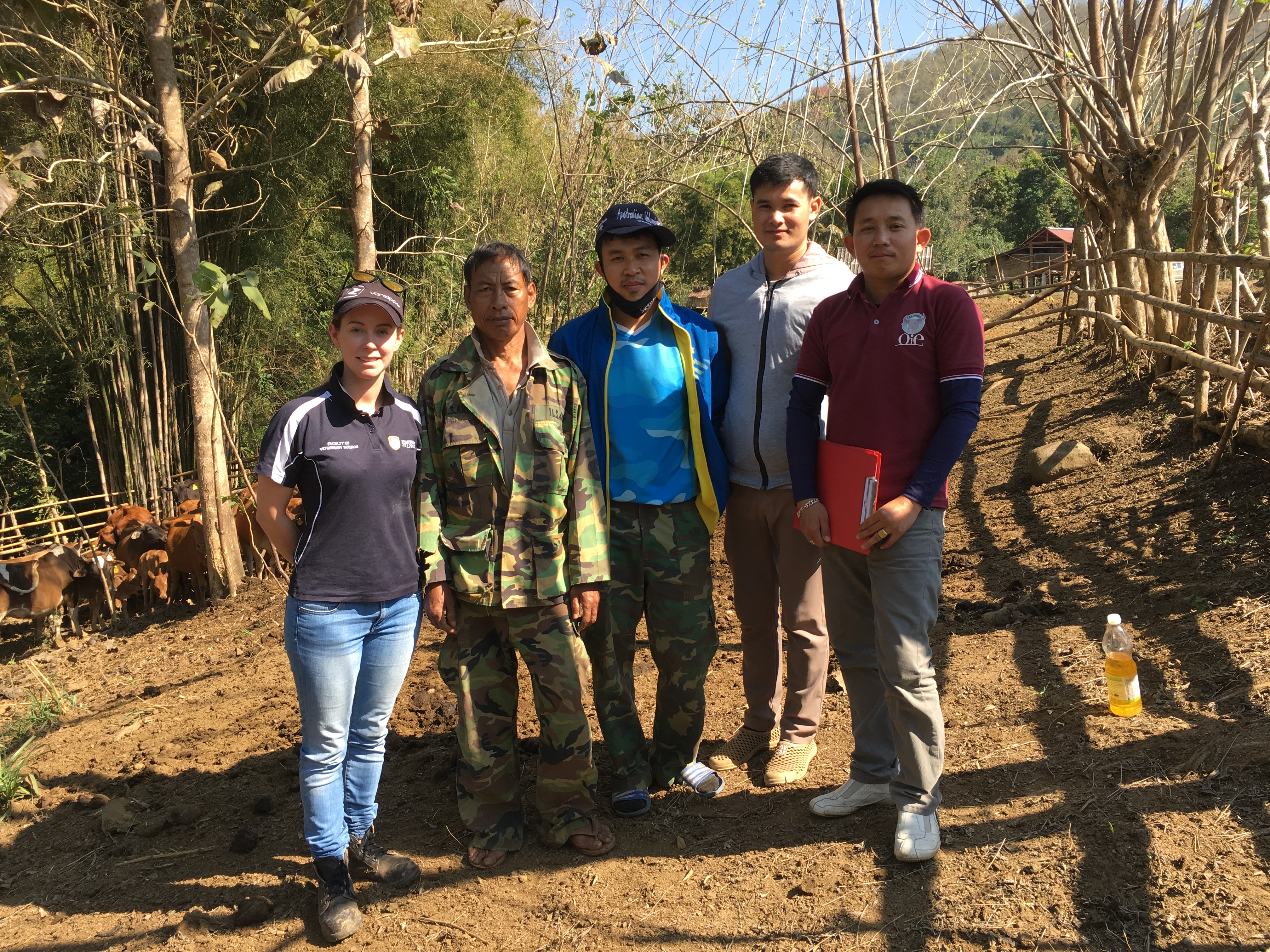
Final year USyd DVM student Geri Pearson (Left) with project farmer (second from left) and block trial team members (Photo: Geri Pearson)
A recent follow up trip was conducted in January 2018 to collect faecal samples from calves and assess body condition to determine the efficacy of these MMBs. Faecal egg counts (FEC) of these samples will be conducted at the Lao Department of Livestock and Fisheries laboratory in Luang Prabang. Faecal collections will continue into February to allow assessments of FEC at 1, 14, 28 and 56 day intervals and help determine the potential efficacy of this approach if applied a larger scale. This research work has received a boost recently with support from DFAT through a successful application by 4 Seasons & the MLR team for a Business Partnership Platform (AUBPP) grant examining the potential for multiple applications of molasses blocks in Laos and potentially the broader Mekong and southeast Asian region.
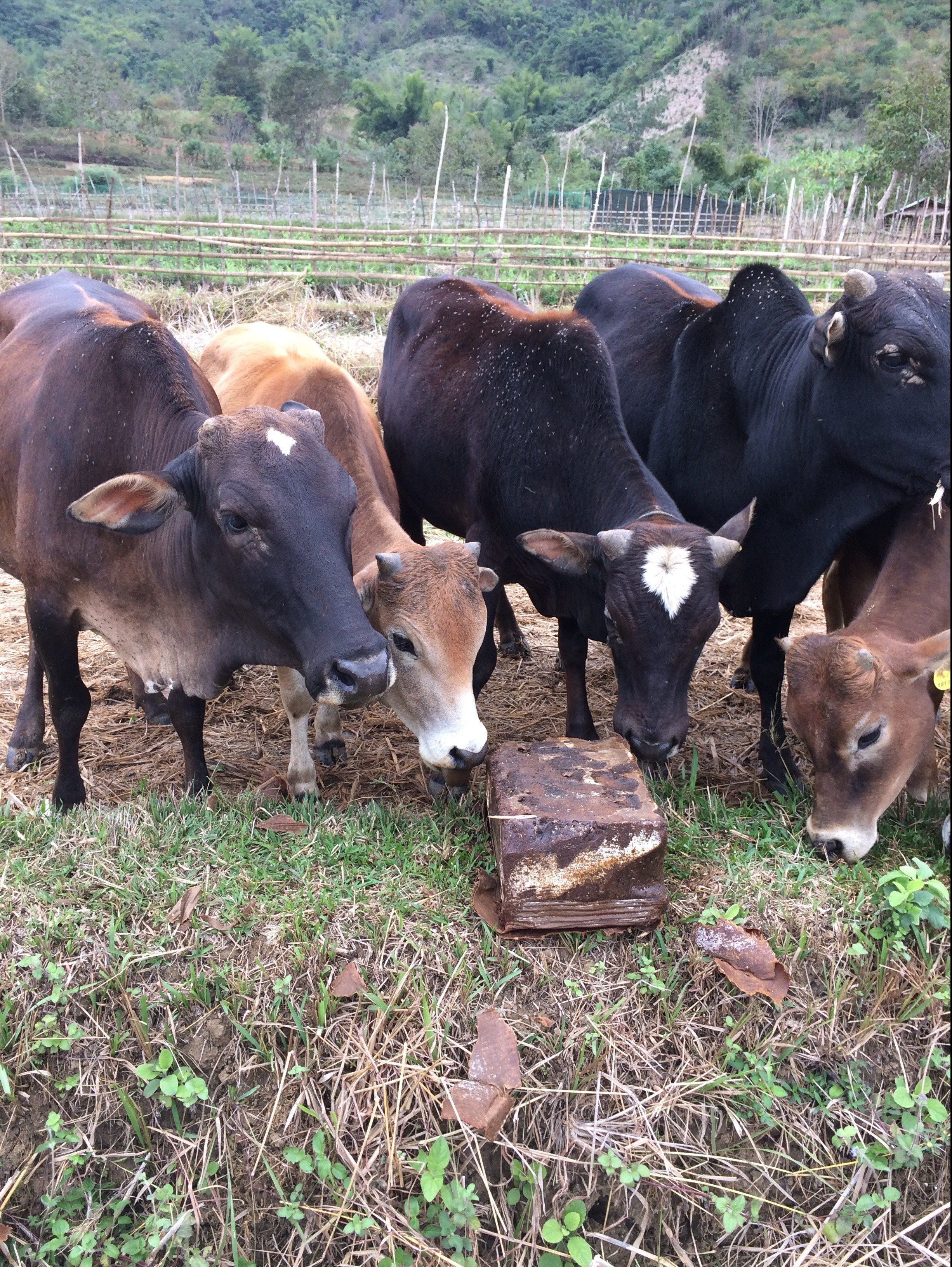
Cows enjoying the MMBs from the trial. Project farmers so far have expressed interest in the continued use of the MMBs (Photo: Sonevilay Nampanya)
Correspondence with farmers during the recent visits indicate they are very pleased with the results as the health and body condition score of their herds continues to improve. Further information on this and other MLR projects aimed at improving large ruminant efficacy and regional food security can be found on the Mekong Livestock Research Blog:
Additional research on parasitic control has also recently been conducted by Dr Sonevilay Nampanya and PhD students Ms Luisa Olmo and Ms Nichola Calvani who all recently presented at the 26th International Conference of the World Association for the Advancement of Veterinary Parasitology (WAAVP) in Kuala Lumpur, Malaysia in September 2017.
ACIAR project kick-off in Vientiane, Laos!
Katherine Ashley (PhD student) – 18th March, 2015
A two-day workshop was held on the 20-21st February marking project commencement of ‘Development of a biosecure market-driven beef production system in Laos PDR (AH/2012/068)’ and ‘Enhancing transboundary livestock disease risk management in Lao PDR (AH/2012/067)’.
Held in Vientiane, Laos, the workshop brought together in-country partners involved in both projects and we were grateful for the presence of the Australian Ambassador to Laos, Mr John Williams, Dr Bounkhoung Khambounheung, Director General, Department of Livestock and Fisheries and representatives from the Asian Development Bank (ADB) and the International Fund for Agricultural Development (IFAD) alongside colleagues from the Department of Livestock and Fisheries, Department of Planning, National Agriculture and Forestry Research Institute, Faculty of Agriculture, National University of Laos and the Faculty of Agriculture and Environmental Science, Savannakhet University.
The inception workshop was an informative and engaging session and provided an in-depth discussion of the project objectives, activities and expected outcomes and the roles and responsibilities of all stakeholders for each project. These discussions were complimented by presentations provided by Lao project staff into the current state of the nations large ruminant sector, the national strategic plan for large ruminant production and the national strategic plan for large ruminant research. The USYD project staff then had the opportunity to provide information to our Lao colleagues on recent studies into the large ruminant market and carcass composition, the prevalence and control of foot-and-mouth disease (FMD) in the region, the financial impact and knowledge of FMD in Laos and the socio-economic impact of improved livestock production and the importance of women and girls in agriculture.
The Mekong Livestock Research team is now looking forward to a busy and productive 2015 with the roll-out of both projects across Laos and working with our in-country partners to develop a biosecure market driven beef production system in Laos and enhance transboundary livestock disease risk management. This will involve close collaboration with project sponsors, project staff and project participants and we look forward to working with these partners to achieve improved smallholder livestock production and health!
Veterinary teaching capacity building links with new ACIAR projects in Lao PDR
17th March, 2015
In mid-2014, Prof Peter Windsor of the Mekong Livestock Research (MLR) Team of the University of Sydney (USYD) Faculty of Veterinary Science, assisted by Mr Sonevilay Nampanya, conducted a curriculum review of the new veterinary degree at the National University of Laos (NUOL) at Nabong campus, near Vientiane capital, Lao PDR. This initiative, supported by the Asian Development Bank (ADB), followed an OIE-led PVS (Provision of Veterinary Services) mission several years ago, when it was recognised that Laos needed to produce veterinary graduates capable of delivering day one competencies (DOC) in veterinary public to meet the SPS (Sanitary & Phytosanitary Services) needs of the country, particularly with increasing Transboundary, Zoonotic and Emerging Disease threats.
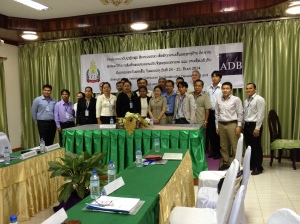
Prof Peter Windsor (back) with Mr Sonevilay Nampanya (2nd from right) at NUOL Curriuculm Review Workshop in Laos, September 2014
NUOL Nabong campus produced the first cohort of 26 BVSc graduates in May 2013 with limited staff and facilities following commencement of training in 2008. Several initiatives are under discussion to provide continuing external support in veterinary teaching at NUOL, particularly with training in clinical practice and upgrading of courses in the veterinary public health disciplines, plus collaboration with USYD research and teaching projects. A proposed upgrade of the current 5 year BVSc to a 6 year DVM was suggested, to harmonise with similar degrees in the region. A new curriculum for the DVM was proposed to build more clarity in the learning for staff and students, and many new initiatives including innovative teaching methodologies in each Unit of Study were suggested to increases the responsibility of students for their own learning. Despite a range of opinions on the numbers of veterinarians required in Laos, there is some consensus that 25 to 30 new vets should graduate per annum, although placing these in employment will require considerable effort in building close stakeholder community partnerships, with several likely to be employed in a new livestock development project funded by ADB and IFAD, and in two new research projects funded by ACIAR, all now commencing in Laos.

Veterinary Teaching staff of the NUOL Nabong campus during the curriculum review process in 2014, with Sonevilay Nampanya (blue T shirt)
The new ACIAR-funded projects are ‘Development of a Biosecure Market-driven production system in Lao PDR’ and ‘Enhancing Transboundary Livestock Disease Risk Management in Lao PDR’, both involving collaboration of the MLR of the USYD, with the Department of Livestock and Fisheries and the National Agricultural and Forestry research institute, plus NUOL and Savannakhet universities. Text books from USYD were presented to Dr Vannaphone Putthana of the Nabong campus Faculty at both a curriculum review workshop for ADB in late 2014, and an ACIAR project inception meeting workshop in Vientiane in February 2015, linking the NUOL curriculum review with current and future activities aimed at building TAD’s and EAD’s capacities in Laos and addressing food security and rural poverty through smallholder livestock development.
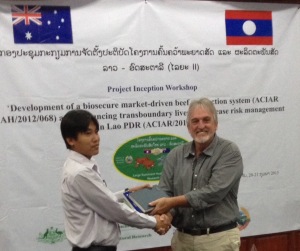
Prof Windsor presents veterinary text books donated by the University of Sydney to Dr Vannaphone Putthana, of NUOL Nabong at the ACIAR project inception meeting in February 2015
For more details, please contact peter.windsor@sydney.edu.au
FOOD SECURITY RESEARCH IN THE MEKONG – SSEAC Seminar Seriers
FOOD SECURITY RESEARCH IN THE MEKONG
Professor Peter Windsor presents an overview of research activities and how on-going research in seeking successful interventions in large ruminant health, production and trade can help improve food security and reduce rural poverty in the Mekong region.






